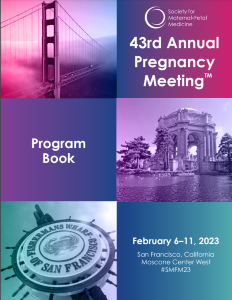Oral Concurrent Session 8 - Placenta & Cesarean
Oral Concurrent Sessions
Expedited Sessions
79 - Implementation of a calculator to predict cesarean during labor induction: the patient perspective
Our group created a well-validated calculator to predict likelihood of cesarean delivery (CD) at the start of labor induction (IOL) [Levine 2018]. Calculator utilization has been associated with decreased CD and maternal morbidity rates [Hamm 2021]. We aimed to understand the patient perspective on counseling around CD risk results.
Study Design:
This qualitative study enrolled English-speaking postpartum patients at one institution with documented counseling around CD risk calculation at the start of IOL from November 2021 to March 2022. Enrollment occurred until thematic saturation was reached in each of 4 CD risk strata ( < 20%, 20-39.9%, 40-59.9%, ≥60%), with purposive sampling by actual delivery mode. Semi -structured interviews were performed regarding (a) understanding of CD risk results, (b) whether and how knowledge of CD risk shapes the patient experience of delivery, and (c) how to optimize CD risk counseling. Interviews were coded using a structured approach by two coders with high inter-rater reliability (k=0.8).
Results:
40 patients (77.5% nulliparous; 75% Black, Indigenous, People of Color) enrolled. 35% of patients reported never considering the possibility of CD prior to IOL (Table). Despite documentation that counseling occurred, >25% of patients did not recall discussing CD risk. When counseling was recalled, some believed risk was lower than documented, and often wrongly attributed CD risk to variables not included in the calculation (ie fetal size, preeclampsia). Most patients with low CD risk felt it put them “at ease”, although some reported risk counseling did not impact experience. Those with high CD risk either felt it prepared for the possibility of CD, or that it increased stress, leading to questioning of the IOL plan, especially if elective. To improve counseling, patients recommended moving the conversation to prenatal care, even if CD risk changes with admission exam.
Conclusion: This work describes how patients experience a commonly used CD risk calculator. These results can be harnessed to optimize CD counseling as calculator implementation becomes more widespread.

Rebecca F. Hamm, MD,MSCE (she/her/hers)
Assistant Professor of Obstetrics and Gynecology
Department of Obstetrics & Gynecology, Perelman School of Medicine, University of Pennsylvania
Philadelphia, Pennsylvania, United States- EW
Eileen Wang, MD
University of Pennsylvania
PHILADELPHIA, PA, United States - JS
Julia E. Szymczak, PhD
University of Pennsylvania
Philadelphia, PA, United States 
Lisa D. Levine, MD, MSCE (she/her/hers)
Associate Professor
Perelman School of Medicine, University of Pennsylvania
Philadelphia, Pennsylvania, United States

.png)
